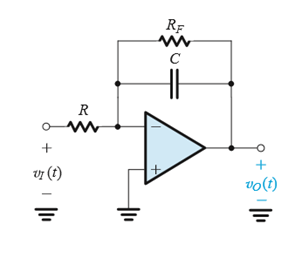This set of Electronic Devices and Circuits Multiple Choice Questions & Answers (MCQs) focuses on “Integrators and Differentiators”.
1. The other name for Miller Circuit is
a) Non-Inverting Integrator
b) Inverting Integrator
c) Non-Inverting Differentiator
d) Inverting Differentiator
View Answer
Explanation: Miller Circuit is also called Inverting integrator.
2. The slope of the frequency response of an integrator is
a) Linear with negative slope
b) Linear with positive slope
c) Exponential increase
d) Exponential decrease
View Answer
Explanation: The slope is linear and negative.
3. The integrating transfer function has the value of
a) jωCR
b) –jωCR
c) 1 / jωCR
d) -1 / jωCR
View Answer
Explanation: Standard mathematical expression for the transfer function.
4. The expression for the integration frequency is
a) CR
b) 1/CR
c) R/C
d) C/R
View Answer
Explanation: Standard mathematical expression for the integrator frequency.
5. Determine the expression for the transfer function for the circuit shown below.

a) (Rf/R)/(1+jωCRfC)
b) (Rf/R)/(1-jωCRfC)
c) – (Rf/R)/(1+jωCRfC)
d) – (Rf/R)/(1-jωCRfC)
View Answer
Explanation: It is a standard expression.
6. The frequency transfer function of a differentiator is given by
a) jωCR
b) 1/jωCR
c) – jωCR
d) – 1/jωCR
View Answer
Explanation: Standard mathematical expression for the transfer function of a differentiator.
7. The slope of the frequency response of a differentiator is
a) Linear with negative slope
b) Linear with positive slope
c) Exponential increase
d) Exponential decrease
View Answer
Explanation: The slope is linear with a positive slope.
8. The phase in the integrator and differentiator circuit respectively are
a) +90 degrees and +90 degrees
b) -90 degrees and -90 degrees
c) -90 degrees and +90 degrees
d) +90 degrees and -90 degrees
View Answer
Explanation: These are the characteristics of the integrators and differentiators circuits respectively.
9. Consider a symmetrical square wave of 20-V peak-to-peak, 0 average, and 2-ms period applied to a Miller integrator. Find the value of the time constant CR such that the triangular waveform at the output has a 20-V peak-to-peak amplitude.
a) 0.25ms
b) 0.50ms
c) 2.5ms
d) 5.0ms
View Answer
Explanation: According to the question 1/CR = 2.
10. The expression for the differentiator time constant is
a) CR
b) 1/CR
c) R/C
d) C/R
View Answer
Explanation: Standard mathematical expression for the time constant for the differentiators.
Sanfoundry Global Education & Learning Series – Electronic Devices and Circuits.
To practice all areas of Electronic Devices and Circuits, here is complete set of 1000+ Multiple Choice Questions and Answers.
If you find a mistake in question / option / answer, kindly take a screenshot and email to [email protected]
